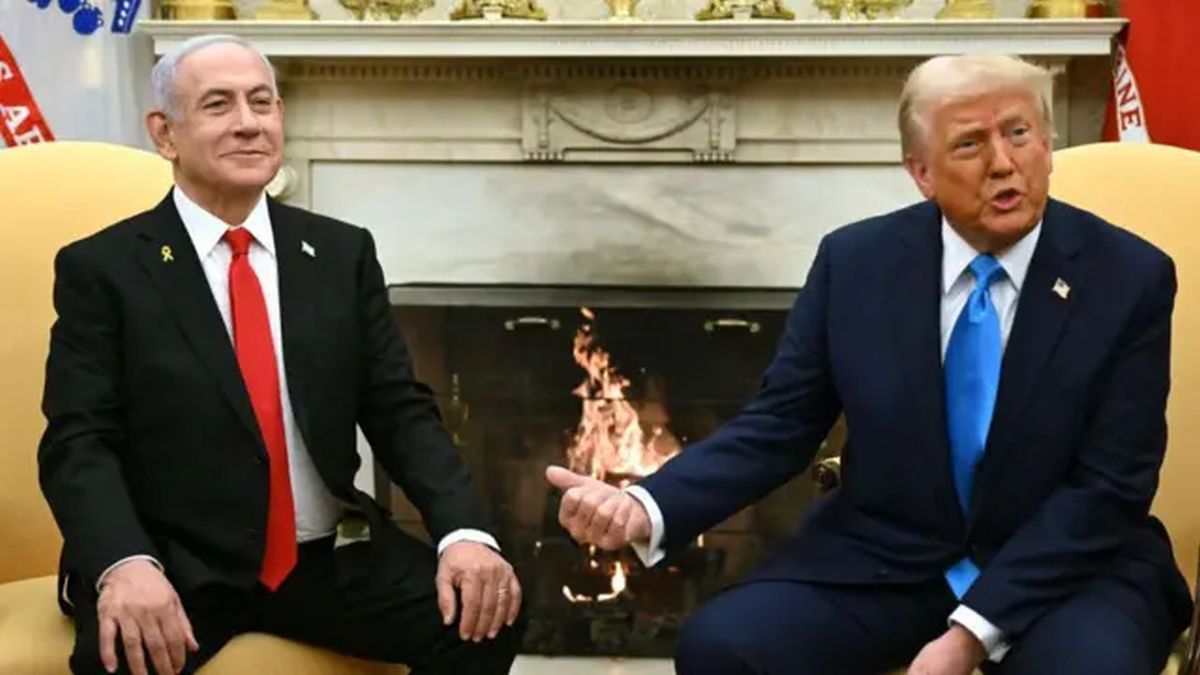The US president wants peace, but Netanyahu has other plans, which force Wall Street to take a step to the side. The world is a dusty, although the storm of trade amaine. The Fed will meet this Tuesday and Wednesday. Will your policy change? Will the rates touch?
Trump finds no peace. His aggressive campaign platform – which is nothing other than his government’s true program – collides with a reality that resists abide by orders. Other weight will –Xi Jinping, Jay Powell, Vladimir Putin, Benjamin Netanyahu and the “vigilantes” of the bond market- are brought with their plans. Thus, the Flag of the Commercial War went quickly in a forced truce, with the total recoil in the “reciprocal tariffs.” And, on the other hand, the dream of leading a world peace process – employed in Ukraine – exploded Friday with Israel’s lightning offensive in Iran, just when Washington and Tehran were preparing to start another round of negotiations.
The content you want to access is exclusive to subscribers.
Who commands here? Where is the pilot? Trump proposes, but other leaderships have. Also ambitious. None amateur. How reliable is the new international order that the real estate magnate came to change, and are changing, or pulling, the others? Wall Street, in a free version of El Gatopardo, was preparing to attack its absolute records, achieved in February, already with Trump in the White House, but when it still considered it harmless and pro-negocios. That is, contained in its most harmful edges. Again perched on the February contributions is a definition. It was easy to think, after seeing him agree with Great Britain and China, that Trump’s run -called mercantilism soon found the last of his shoe.


It’s true, Netanyahu’s plans force Wall Street to step aside. The world is a dusty, although the storm of trade amaine. Wall Street feels no interest in geopolitics, but will not advance ahead of missiles. It conserves fresh the lesson of the invasion to Ukraine. Do not hurry. There will already be revenge time. Fortunately, the civil land reveals a substantial difference: the Fed is neutral. This time yours is to see and wait. Today monetary policy is at peace. Not as in 2022 when he ran a rampant inflation (9.1% in the middle of that year). He then needed six rates, including four consecutive cannons of 75 base points, in as many meetings, from June to November, to calm it. And had to continue in 2023.
Inflation: wars lengthen their influence
Inflation istherefore, A fundamental factor of the situation. And the wars bring their influence. The tariff bid is an artillery that is incessant since March. Under their influence, consumer prices fell 0.1% that month, and climbed just 0.2% in April and 0.1% in May. Believe or not, interannual inflation sank half a point in the year. It went from 2.9% in 2024 to 2.4%, last month. Its core version diminished 3.2% to 2.8%. The last measurement of the deflator of personal consumption – which is the rod that uses the Fed – was in April only one tenth above the goal of 2%. The improvement is remarkable. Will there be crouched inflation incubating the production chain? Yes, but wholesale prices fell 0.1% in March and 0.2% in April to climb only 0.1% in May. Inter -man wholesale inflation is 2.6%. In December it was 3.5%. And if one is deepened, and rummage into the prices of unprocessed goods for intermediate demand – what it finds is an interannual drop of 1%.
The tariff war is an eruption volcano. The effective average tax was around 3% last year and today is 21.9%, the highest since 1909. His explosion was abrupt, although diminishing. Surprisingly the only damage is detected in specific prices and in the soft data (such as PMI reports). The strongest blow has been psychological: Consumer confidence collapsed in May to the second lowest level than work in the records, anticipating a possible recession. Their expectations of one year inflation climbed up to 6.6% in May (after a preliminary reading of 7.3%), the highest in 40 years.
But In June there was a positive reaction. Trust was repurified for the first time in the year. And the expected inflation decreased to 5.1% to one year (and 4.1% to ten years). Nothing more balsamic than to see Trump backing on his most toxic agenda. What relieved markets in April now also calms the consumer. In 2022, the opposite happened. The stock market collapsed in advance and produced a Bear market before even that the Fed would raise its rates. It was the consumer who loaded the economy on his shoulder and avoided a recession. That is calm on time is crucial for the success of the journey.
What will the Fed do when it meets this week?
The Fed, already said, wants to see and wait. I wanted to see something like that, but I didn’t expect it. Inflation reports are excellent, admitted Austan Goolsbee of Chicago’s Fed before knowing May, which is the best. A priori, a tariff jump does not have to raise inflation, although it justifies a rise in prices for once. But the increase was massive, it operated increasingly and shot repaires. The expectations – as the consumer denotes – could be disagree. The important thing is that it was absorbed without a dent and an overflow was avoided, which will be less likely to occur as the shock loses power.
The Fed will meet this Tuesday and Wednesday. Will your policy change? Will the rates touch? Jay Powell saw what he wanted to see. But, he will extend the wait. You can adjust your speech and record the obvious progress of inflation. Unfortunately, now the war moved in front. And the inflationary dangers, too. The cheap energy, a Trump obsession, shattered before the first missile was launched. The price of Brent crude barrel climbed 20% since the beginning of June. It is another conato of stagging shock that breaks from prepo. The novelty is that Trump undermined the reputation of US assets with his April crusade, and neither the dollar nor the treasure bonds are the safe shelters of the once. The Fed must be more careful, then. Even so, it is likely that your priority is no longer exclusively to set inflation expectations. It must increase the surveillance of the health of activity and employment. At least, Wall Street thinks about it. The global energy offer (and commodities) is elastic if some time to respond (another lesson of Ukraine) is granted. That is why the markets insist with the idea that the Fed will lower the rates, not one but twice, not now but before the end of the year. Tariff rise is an imposite. The labor market slows down. And orders for unemployment subsidies increase week after week. Seen like that, and with inflation at bay, it does not seem a crazy bet. We will have to wait, yes, that the Congress (and the vigilantes of the bond market) define the fiscal course and, incidentally, that Israel has succeeded in truncating Iran’s nuclear plan.
Source: Ambito




